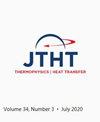利用磁场减少薄环形池中的热毛细对流
IF 1.7
4区 工程技术
Q4 ENGINEERING, MECHANICAL
引用次数: 0
摘要
本文研究了在垂直磁场下含有硅熔体的三种环形间隙的三维(3-D)薄池中的热毛细对流。模型由两个垂直的墙组成:里面是冷的,外面是热的。辐射从自由顶部表面向上发射,底部垂直加热。本研究考虑了这两种情况,即对所有墙壁进行电绝缘;并且对于三个环形间隙只有底壁是导电的。采用有限体积法对控制方程进行了数值求解。研究了不同参数(如哈特曼数、环形间隙)对温度分布、热液波数和方位角模式的影响,以及从三维稳定流到轴对称流的转变。结果表明,在三维稳定流动中观测到三个热液波。研究还发现,随着哈特曼数的增加,方位角速度、温度波动和电势都减小了。结果还表明,从非定常流过渡到非轴对称定常流,并在过渡结束时过渡到稳定轴对称流,需要更强的磁场。研究结果表明,当底壁导电时,电磁阻尼比所有壁都绝缘时更突出。本文章由计算机程序翻译,如有差异,请以英文原文为准。
Using a Magnetic Field to Reduce Thermocapillary Convection in Thin Annular Pools
This paper presents the investigation of thermocapillary convection in three-dimensional (3-D) thin pools with three cases of annular gaps containing silicon melt under a vertical magnetic field. The model was composed of two vertical walls: the inner is cold, and the outside is hot. Radiation is emitted upward from the free top surface, and the bottom is heated vertically. Both cases are considered in this study, electrically insulating all walls; and only the bottom wall is electrically conducting for three annular gaps. The governing equations were solved numerically through the finite volume method. The effects of different parameters such as the Hartmann number, annular gaps on the temperature distribution, the hydrothermal wave number, and azimuthal patterns, as well as the transition from 3-D steady to axisymmetric flows, were investigated. The results showed three hydrothermal waves are observed in a 3-D steady flow. It was also found that with the increasing Hartmann number, the azimuthal velocity, the temperature fluctuation, and the electric potential decreased. The results also revealed that a stronger magnetic field was needed for the transition from unsteady flow to a nonaxisymmetric steady flow and at the end to steady axisymmetric flow. The findings revealed that electromagnetic damping is more prominent when the bottom wall is electrically conducting than when all walls are insulating.
求助全文
通过发布文献求助,成功后即可免费获取论文全文。
去求助
来源期刊

Journal of Thermophysics and Heat Transfer
工程技术-工程:机械
CiteScore
3.50
自引率
19.00%
发文量
95
审稿时长
3 months
期刊介绍:
This Journal is devoted to the advancement of the science and technology of thermophysics and heat transfer through the dissemination of original research papers disclosing new technical knowledge and exploratory developments and applications based on new knowledge. The Journal publishes qualified papers that deal with the properties and mechanisms involved in thermal energy transfer and storage in gases, liquids, and solids or combinations thereof. These studies include aerothermodynamics; conductive, convective, radiative, and multiphase modes of heat transfer; micro- and nano-scale heat transfer; nonintrusive diagnostics; numerical and experimental techniques; plasma excitation and flow interactions; thermal systems; and thermophysical properties. Papers that review recent research developments in any of the prior topics are also solicited.
 求助内容:
求助内容: 应助结果提醒方式:
应助结果提醒方式:


